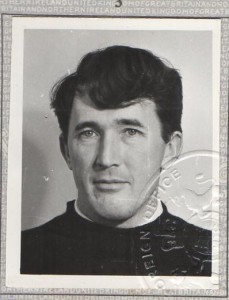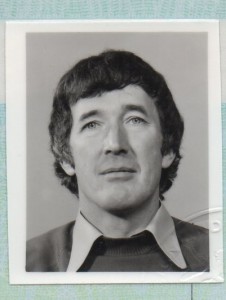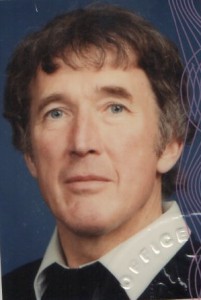RWPMW wrote the following account of his life towards the end of 2001. Towards the end of 2008, as he approached his eighty first birthday, he had another seven years to account for. His notes on this period are appended to the 2001 text which is more or less in its original form.
The full text of Peter’s autiobiography has been broken into several chapters. The flow through the original document is as follows
RWPMW – the early working years
From this time my career really took off. I made my first visit to the United States in the summer of 1961 and arranged to spend a year there as a JILA fellow the following year. This last was a great success both from the point of view of the family and for me scientifically. By this time both Tessa and Fiona had been born. We bought our first new car and took it with us on the Cunard Line’s Mauritania for a truly memorable crossing. We arrived in New York just as the Sun was rising and to a full moon – a magical experience. After spending a couple of weeks with the Wieses we moved into our own apartment for the winter of 1962-63 in Bethesda on the outskirts of Washington, D.C. I worked with Wolfgang Wiese at the Bureau of Standards, in downtown Washington in those days. I designed an experiment to study the question of LTE in the plasma formed in a shock tube and was able to complete it and publish in the course of the year. I also made many visits to the Naval Research Laboratory and did some work with Alan Kolb and Hans Griem there. We enjoyed the cultural life of Washington at that time mostly in the company of the Wieses.
For Christmas we accepted an invitation from Barry Tomlinson to spend it with him in Miami Florida. This was yet another marvellous experience with a Christmas tree made from palm leaves and a swim in the sea the day before. In Washington Joy and I joined the St Andrews Society which resulted in us getting an invitation to attend a visit to the White House by the Black Watch. This came when I was about to leave for home in the autumn of 1963 and I didn’t go – something I have regretted ever since. It was the last event held by Kennedy in the White House before he was assassinated. In the spring of 1963 we packed our things and set off for Boulder, Colorado by way of Ottawa and the Great Lakes. In Ottawa we visited Stuart Ramsden and Mike Tomlinson. Most nights we camped which was a great success with the two girls. In Boulder we rented a house from Rex Walker a larger-then-life Texan who ran a dude ranch in the mountains. I worked at the Joint Institute for Laboratory Astrophysics (JILA) mostly writing a chapter for a book. From Boulder we visited Los Alamos and got to know the Jahodas and the Gemmels. Here too I did some science and got another publication out of it. Boulder was a great place to spend the summer and we had a marvellous time exploring the mountains where we did a lot of camping. At the end of the summer we took a more southerly route back to Washington again camping most nights. By one of the most remarkable coincidences of my life while walking with Joy and the girls in the Smokey Mountains National Park we met the fellow who used to sit next to me in the physics class in Glasgow in the 1940’s! While Joy and the girls went home I stayed on having negotiated an extra month to complete the work I had started at the Bureau of Standards and which I had been running by telephone with my collaborator Ken Ekerlie in Washington from Boulder. It was at this time I had the White House invitation. A few days later Kennedy was shot and the whole country went into mourning. I was able to watch from the kerbside the cortege passing with all the world’s politicians following behind on foot – I especially remember seeing DeGaulle towering above them all. I returned home on the Queen Mary which was again lovely and drove immediately on landing to Newton Abbot where Joy and the children had stayed with Joy’s parents. So ended a marvellous year both scientifically for me and for our family life.
We all returned to Blewbury to take up our lives where we had left off thirteen months previously. Martin and Rosie Sylvester were still occupying our house while their new one was being completed so we moved into a little cottage owned by the Saunders. This provided us with a home till it was time to head north to spend Christmas with my parents in Silverburn. Life settled down again to its old pattern although we decided to have another child and to move house partly as a result. Tessa started school in Abingdon and the division with whom I worked were in the process of moving to the Culham Laboratory. After some searching we chose to buy 13 Park Crescent in Abingdon (for £7500). This was the winter of 1964-5 and Gavin was on his way to be born on April 23, 1965. We had some difficulty selling our Blewbury house and owned both for most of the summer – rather expensive. However 13 PC needed a lot doing to it and we couldn’t have moved in much earlier. I rewired it myself and spent long hours with the floor boards up and cutting holes for the plugs etc. Finally in the autumn the Forge was sold and we moved in despite there being no windows in the kitchen. It was at this time that Joy’s mother died on 1964 Oct. 6 in Newton Abbot. I was abroad at a scientific meeting at the time and have regretted since that I didn’t return to support her. Her father lived on for eight years and used to visit us in Abingdon. He died on 1972 Oct 4 also in Newton Abbot. Park Crescent seemed to be inhabited by ageing couples whose children had all left home except maybe for the Kendals a few doors down. However Blewbury was near enough that we could retain contact with our friends there and we made little effort to get to know our new neighbours. Joy was happy that there was a grass tennis court in the park across the road and she was soon established there to become one of the leading lights of the club.
My place of work was the Culham Laboratory although I still had a major interest in the use of Zeta for the measurement of electron collision coefficients for nitrogen V and neon VII. This turned out to be a particularly difficult experiment and although with Jim Lang I put in a lot of effort the final accuracy was not what we had hoped for. Although I should have been the first author of the subsequent paper I thought it would help Jim if he was the sole author and for this reason left my name off. In retrospect I think this was a mistake because it probably gave the impression that the paper did not have my full support which in fact it did. It would probably have been better received if I had been an author. Besides the Zeta experiment I was responsible for some spectroscopic work on laser produced plasmas and on the dynamics of these plasmas. I had quite a substantial group of people for whom I was responsible and of whom about a dozen had PhD’s.
It was about this time (circa 1969) that a decision was taken by the Atomic Energy Authority to close down our Spectroscopy Division mainly because it was felt that measurement of electron temperature could better be done using lasers. We started looking for jobs elsewhere and I went after two: one in Frascati just outside Rome at the European Space Research Institute and the other at the University of Stirling where they were looking for a professor of experimental physics. I attended interviews for both and was offered the job in Stirling and was given the impression that I could have the one in Frascati if I wanted it. It was tempting to me to return to Scotland but I felt it would be less attractive to the family who were well settled in Abingdon. During the same period Bob Wilson had been negotiating with the Science Resaearch Council to have them take over our Division. In this he was successful and I decided to stay with the Division which now acquired the name Astrophysics Research Unit. We were given the same funding as before but had complete freedom in choice of research project. We continued to occupy the same space at the Culham Laboratory. This arrangement continued for some years and we had a very happy time. While continuing much of the experimental work that I had been responsible for I started a calculation of the power loss by the outer solar atmosphere by spectral line radiation. This became the standard calculation in this field. In fact some years earlier I had done a similar calculation that showed that the power loss by radiation from one percent of iron impurity in a thermonuclear plasma would be greater than the loss due to Hydrogen bremmstrahlung. If this had been known at the time it might have meant that spectroscopy would have been looked upon more favourably and we might have remained with the fusion project. But I didn’t publish the work except in an internal report. Other projects included the calculation of the properties of the solar atmosphere with the assumption that it was heated by acoustic waves. This was less successful and it is generally accepted that this is not the correct heating mechanism. The main emphasis of my work moved towards theory of the solar atmosphere including a little later a calculation of the acceleration of the solar wind by the action of Alfven waves. However my programme did include work on a proposal to build a grazing incidence spectrometer to observe the sun from above the earth’s atmosphere. This I did in association with Gethyn and Adriene Timothy. It was accepted for funding by SRC but unfortunately the Timothies decided to leave for USA and I was unable to find any other suitable collaborators. It was about this time that I was promoted to be a Senior Principle Scientific Officer on individual merit which meant that I was able to select my own research projects. It was only later that I realised what a great benefit this was.
My mother died on 1981 Oct. 4. She had been deteriorating in health for some years and had been looked after by father. It must have been very hard for him. Mother’s mental condition was such that she didn’t know father as her husband. Although it was not recognised at the time father in retrospect reckoned that she suffered from Alzheimer’s disease. I was in American when he phoned to say that her condition had become worse and he didn’t expect her to live for many more days so I flew home to be with him and my sister. After mother’s death, having sold his own house, father shared his time living alternately with Wendy in Glasgow and later Edinburgh and us in Abingdon. He died finally of ‘left cerebral glycoma’ on 1985 Nov. 27 in Abingdon. He had taken great care to arrange his affairs so that we had little to do in the way of tidying up after him. He had spent a lot of time in his retirement researching the McWhirter family history which he wrote up in a large notebook which I now have and which he called the ‘Saga of John and Anna’.
These were busy years for me at work as I continued to be involved with some laboratory work as well as interpretation of spectroscopic solar observations from space craft, serving on various committees, giving lectures and working on the theory of the solar atmosphere. I count myself incredibly lucky to have been involved in so many interesting projects and to have worked with so many good people. These activities involved a lot of travel both to Europe and North America. Besides the year spent in Washinton and Boulder in 1962-63 I was able to take the family with me on a two to three month visit to Boulder in 1974 when we also visited Felicity and John Pocock first in St Louis and then, after they had moved, in Baltimore on our return to the UK. Usually however I was alone on these American trips and reckon that I must have crossed the Atlantic about one hundred times in my career. In 1986 I was offered a fellowship to visit Japan for nine weeks (October and November 1986). I went to Nagoya University where I worked with Takako Kato. I lived in a little bungalow where I cooked for myself — mostly rice and eggs with lots of vegetables but little meat. Most evenings I went out with my colleagues to eat in a small restaurant which was cheap and not very good but interesting. I seemed to spend a lot of time visiting various universities to give lectures including Kyoto, Hiroshima and Tokyo. In Kyoto I worked with Takashi Fujimoto and we managed to write a paper together. Scientifically this period was not a great success mainly because I was never sure what the Japanese wanted from me in return for their very generous fellowship money. Everybody was very kind and I had a marvellous time. I wrote a diary which gives a day by day account of this visit. Also my photographs are all collected together in an album.
On returning home to Abingdon from Japan I took up where I had left off. Although I didn’t realise it at this time 1987 turned out to be my last year in full time employment. I was approaching 60 and I had understood that I would be free to continue work for as long as I wanted till I was 65 when I was bound to retire. In fact I wrote to the administrators and had this confirmed in writing. However I also felt I wanted to discuss the last years of work with the lab director and arranged to see him. He had gone through my papers and had discovered that in fact because I had signed a particular version of my contract I was due to retire at the end of 1987 at age 60. This was a bit of a blow to begin with but I soon realised that I would be able to continue with what work I wanted and have the freedom to do other things as well; unfortunately with less pay. So I started into retirement.



